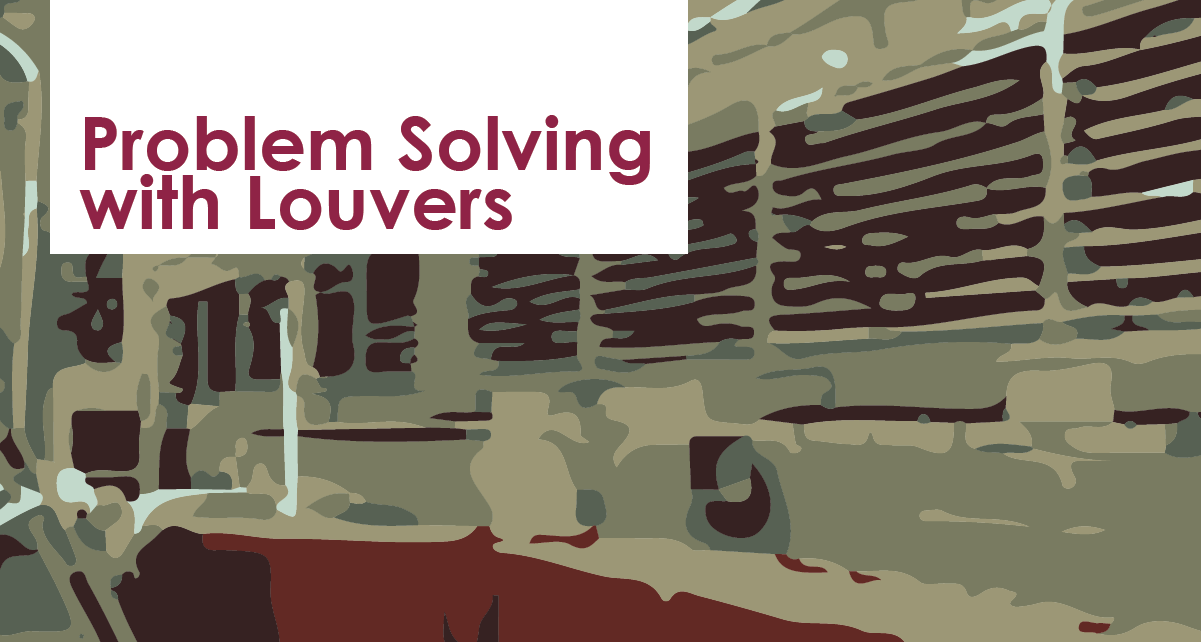Your project has problems that louvers can fix. Keep air intake openings dry and provide air for large spaces. Solve problems with the right louver.
Louvers and Specifications, Solving Problems
There is a lot to consider when designing a building. That is why specification documents are so important. Specifications are the plans for your building. They list every material and component involved in constructing the finished product, a building for inhabitants to live and work.

Specs contain the details of the project, from the materials to the work required, to the standards and codes that must be met when the project is complete. For instance, the specifications will list requirements of each louver, including specific testing standards like AMCA 500-L and AMCA 540. For more details on louver specs, check out this Newsstand article on the topic.
Think of specifications as a list of solutions to potential problems. For example, your building will draw air into the HVAC system through openings in its walls. The problem with this is that unwanted elements, like rain, will try to pass into the system. You will need to protect these openings from water damage with louvers.
Learn more about louvers with the MCDLG Newsstand:
- Three Common Types of Intake Louvers
- The Condenser - Louver Style for Building Aesthetics
- Hurricane Louvers and Severe Duty Protection
.png?width=975&height=300&name=HubspotBlog%20Louver%20Options%20-%20Louvers%20(Resize%2c%20HS).png)
How do you keep interior spaces dry when it’s raining? How do you ventilate a large interior space, like a warehouse or a data center? What if a room in your building has too much sunlight? That can make it harder to cool those rooms in the summer months. Each listing on the spec is an answer to these questions.
Louvers can fix these problems. They protect ventilation openings from water damage, provide shade, conceal areas from onlookers, or add aesthetic flair to a wall. They have a versatile design. However, there are several kinds of louvers. You need to know which one will work best.
Problem 1: Water damage at the air intake point
The primary purpose of a louver is to protect intake and exhaust openings from water damage. These openings often contain ductwork that leads to other parts of the HVAC system. The system will need to draw air in and push it out, even when it’s raining outside. It is important to keep this ductwork dry. Water damage in ductwork will take two forms: mold growth and corrosion.

Mold at the intake point will affect the indoor air quality of the building and may spur mold growth in other parts of the system, which will have a major impact on indoor air quality. It will be difficult to clean these areas, especially if the intake point is high up along the building's profile.
Corrosion damages components around the louver, including the duct work itself. Not all parts will be made from rustproof materials. The damage may not be apparent at first, but corroded parts will fail over time. This could result in more serious issues for your HVAC system, such as ductwork detaching from the intake point.
The louver could be unseated from the opening if its angle clips are rusted from constant exposure to water. An unseated louver can cause considerable damage to your HVAC system.
The solution: Louvers rated for water penetration
It may seem like any louver would fix the issue, but its more complex than it seems. In industry terms, louvers prevent water penetration. To put it simply, they prevent water from passing through to the ductwork inside the opening. The answer involves a little more work.

Most louvers will have a beginning point of water penetration, which is determined through AMCA testing standards. Your louvers should reject rainwater during air intake, so that no water infiltrates into the duct. For more serious weather conditions, you may need a wind driven rain louver to protect your openings.
Problem 2: Ventilating large areas
Not all areas will be divided into smaller rooms, like the rooms of an office building. You may need to pass air throughout a large room. Think of a large, open space. In modern times, that space can be a warehouse for processing online orders. This area needs to be big, so occupants have plenty of space to work.

Think of the data center where the orders are placed. It’s often overlooked, but these computers need constant cooling to keep up with demand. Data centers can house thousands of servers and computers. This equipment needs adequate ventilation.
Any large space can be difficult to ventilate. You need to design your HVAC system to handle these demands. You may need larger ventilation openings to pull more air in.
The solution: Multi-panel louvers
Every louver has a maximum panel size, but you can fill larger openings with a multi-panel assembly. Manufacturers can connect two or more units of the same louver into a larger unit, so that they can cover more area. This is known as a multi-panel assembly.

When two louvers are connected, they create a mullion in the assembly. Mullions are horizontal and vertical dividing lines between louver panels. You can keep these mullions as they are, or you can choose to hide them. Standard mullions have negligible effect on the louver’s performance.
Hidden mullions will require special construction. They are not always available for every louver. Check the louver’s submittal for your options.
Problem 3: Too much direct sunlight
Windows provide a portal to the outdoors, allowing natural light into interior spaces. Natural light is a terrific way to make spaces feel more open, and it provides an energy-free source of light throughout the day. However, this light comes at a cost.

Radiant heat will build up over the course of the day, especially when the sun shines directly through the window. This heat can make it uncomfortable for occupants situated near these windows.
These rooms will be hotter than other rooms in the building, because of the building radiant heat. It also places a heavy load on your HVAC system. Your system will need to work harder than ever to keep the same comfortable temperature throughout the day. This can be especially difficult in the summer months when your system is already working overtime to keep everyone comfortable.
The solution: Sunshades
Sunshades are designed to block direct sunlight at key points in the day, minimizing the amount of radiant heat that passes to the window. Learn more about sunshades with this Newsstand article. These specialty louvers are typically mounted over windows that receive the most sunlight throughout the day.

You will need to read up on the solar angles of your project’s location to determine which windows should receive sunshades. Consider the size and location of your sunshades before ordering them. A well-placed sunshade will block out most of the direct sunlight, keeping the interior space cool without the extra strain on your HVAC system.
The Versatility of Louvers
Despite their uncomplicated design, louvers are versatile. Each louver type can solve a particular set of problems in your building. The key is understanding the needs of your project. Where do you need louvers in your building? Will you have windows that face the sun? Solve these problems by adding the right louvers to your specifications.

Have you solved one of these problems with a louver? Are there other issues that a louver can solve? Tell us in the Comments section. We want to hear from you!
.webp?width=91&height=70&name=MCDLG%20Logo%20(Resize).webp)





